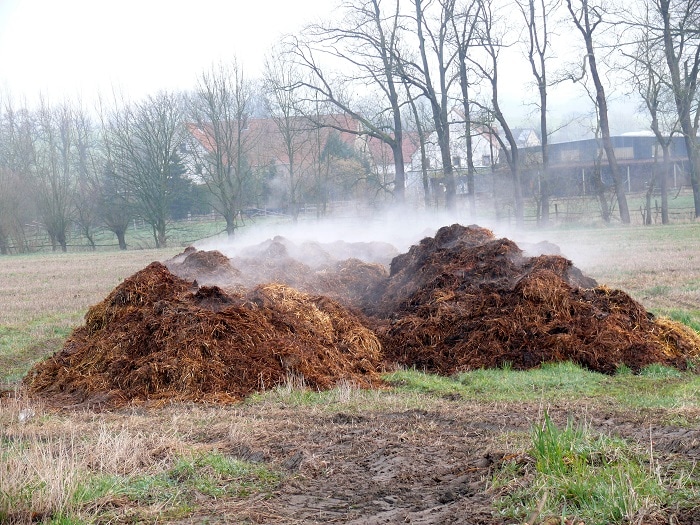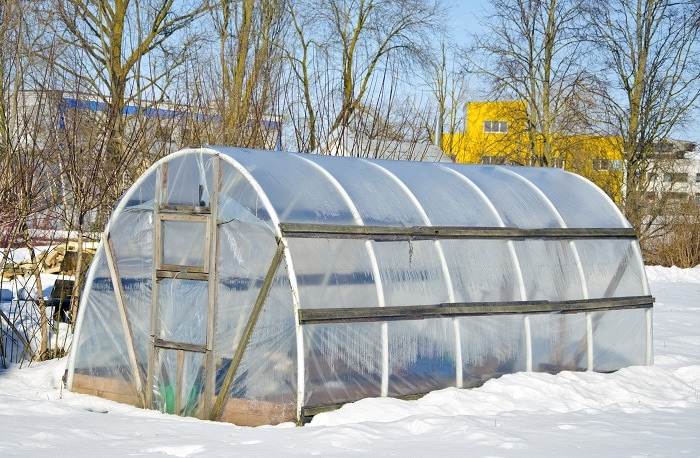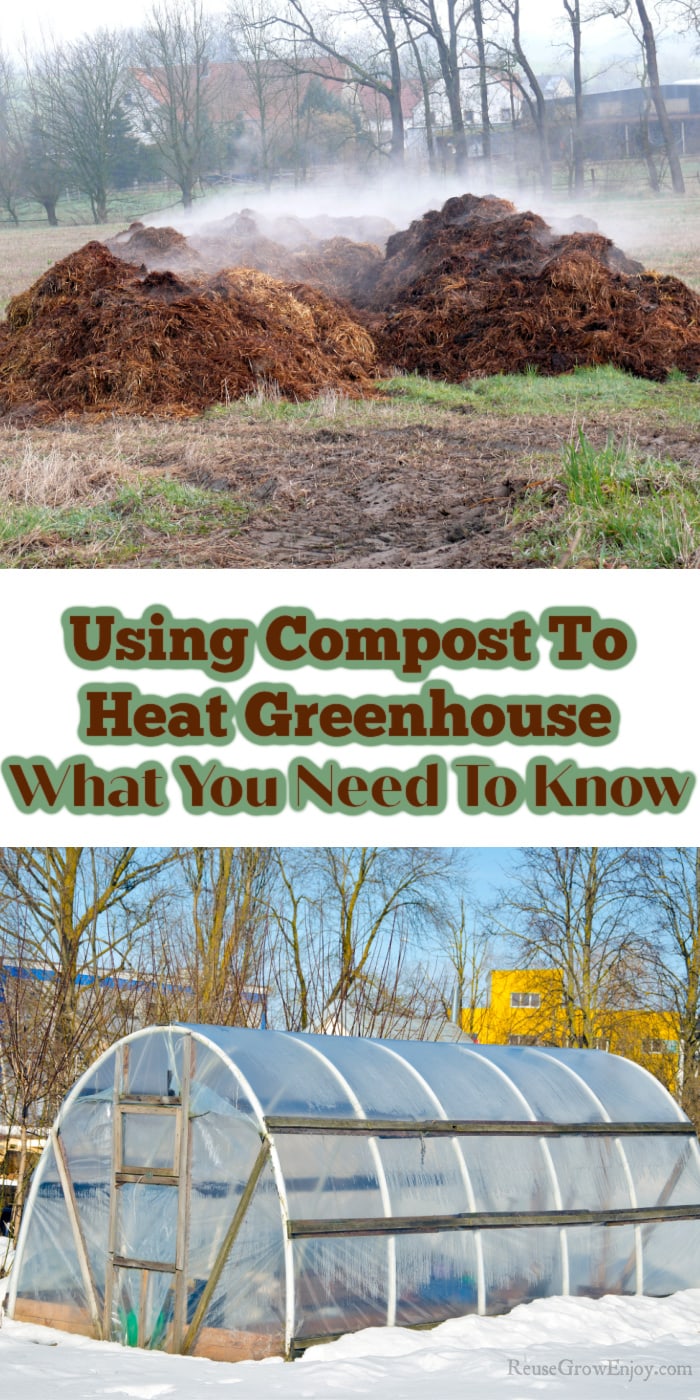Have you ever heard of using compost to heat greenhouse? It may not be an option for your main source of heat if you live in a super cold climate. It is a great option if you just need to knock off the chill from the cold air.

We touched on using compost to heat greenhouse in our post on How To Heat Greenhouse In Winter Without Electricity. But this time we are going to go in-depth on compost heating. We will also go over a few different ways to compost.
How Composting Can Heat Your Greenhouse:
If you are looking for a way to heat your greenhouse you may have to look no further than your compost pile.
Some methods of compost produce a large amount of heat in the process of breaking down your raw organic matter and turning it into fertile compost for your garden.
These composting methods can be used for producing heat that can be used for heating your greenhouse. It can also be used as a heating system for other areas around your homestead such as animal enclosures.
As bacteria work to break down your compost they release heat and gasses that produce heat. Much of this heat is trapped in the center of your compost. But it can work its way out through radiation and be released during the turning process.
This heat can then be trapped in or transferred to your greenhouse. Either through a piping system or directly in the greenhouse to help keep your plants warm as the weather outside gets colder.
This is an economical and earth-friendly way to help your plants thrive as the temperatures dip lower. Though you will need another heat source if you live in a very cold area.
Directly Using Compost To Heat Greenhouse:
The shelter of your greenhouse can help trap moisture and heat, speeding up the composting process as well, allowing you to produce more rich fertile compost at a time.
The size of your compost pile needs to be larger so your compost bin needs to be at least 4 foot by 4 foot. For even heat, you will heat to place it towards the center of your greenhouse.
Though you may find that you need another location to have nearby ventilation in case something goes wrong with your compost pile.
Things To Think Of When Direct Composting:
Composting can provide heat for your greenhouse though the increased heat will speed up the composting. So if you wish to use compost to heat your greenhouse you will need a constant source of ingredients for your compost pile. Or you will lose your heat source in just a few short weeks.
For those that run a restaurant or can get free materials from a high-volume business, composting can be a wonderful heat source for your greenhouse all winter long.
If you are looking to heat your greenhouse only for a short period of time anyone can usually find enough ingredients for heating their greenhouse for a few weeks to extend the end of their cold weather growing season and help plants that need warmer temperatures thrive.
For those in very cold areas or facing an extended cold winter, you can still use your compost to act as supplemental heat for your greenhouse. But should consider these other ways to heat your greenhouse as well.
It is worth noting that composting can be used to heat a greenhouse only when the temperatures are not very low. As it does not produce enough heat to fight extended below-zero temperatures.
In cold climates, additional heating systems may be required to keep the greenhouse at a comfortable temperature for your plants but compost can be a great supplemental option that helps to produce valuable nutrients for your garden.
Creating A Biomass Heating System:
For producing more usable heat for your greenhouse without taking up all of the space you have you can use hot composting and a biomass heating system for greenhouse heating.
This is also much safer if using a massive scale composting pile. The biomass will in turn create thermal mass heating.
During very cold weather, this will not work because your compost pile must remain hot to do its job. A large enough pile can produce heat for quite a while though.
Hot composting or composting manure can produce a lot of heat that is perfect for setting up a heating system to help keep your greenhouse warm.
This can take a bit of work to set up a heat exchanger. But the end result is a great heating system that can help keep your greenhouse warmer. Extending your growing season without adding to your power bills for heating your greenhouse.
Installing tubing at the bottom of the mound as well as in the center of your compost pile allows you to direct the heat from your pile into pipes that then help to heat your greenhouse.
You will also need to bury the piping running from the pile to the greenhouse so you do not lose heat when exposed to the outside air.
This form of using compost to heat a greenhouse is best if you have access to animal manure. As well as other things that compost extremely hot and produce a lot of gasses.
This method may require some engineering. But can be a great way for a larger farm to make use of available resources.
Things To Think About Using A Biomass Heating System:
This will take some time and a lot of work to get the system set up. However, after it is set up you can pretty much leave it alone.
It will require some additional expenses to start. You will need water pipes, a ring of hay bales, and some ventilation pipes.
You will also need some wood chips or a load of sawdust, organic matter, fresh horse manure or fresh manure from other livestock, and other compost materials.
Different Types Of Composting Methods For Your Greenhouse:
While there is a wide range of composting methods including both heat-producing composting methods and ones that remain colder like vermicomposting.
Finding the right composting solution for your greenhouse can help reach your goals. From producing compost for your plants to providing your greenhouse with much-needed heat.
Compost Tumblers:
A compost tumbler is a type of compost bin that allows for easy turning of the compost pile by rotating the bin on its axis.
This can be a convenient way to use hot composting to heat a greenhouse. As it allows for easy aeration of the pile and can speed up the decomposition process.
These tumblers are great for backyard gardens. And they do produce some heat as well as work to collect solar energy heat during the day from the dark plastic being hit by the sun through the walls of the greenhouse.
Keeping this inside of your greenhouse will both provide a few degrees of heat to the area around it and speed up the composting process.
The bigger the tumbler the more heat it is capable of producing provided you properly care for it.
This is a great option to help add some heat to your green hose as a compliment to your heating system or during the fall to help extend the growing season by a couple of weeks while it is relatively warm during the day.
If you do not have the room for a large compost pile and want to compost over the winter months your greenhouse can greatly extend how long you can do so.
Hot Composting:
Hot composting produces a lot of heat. If you are properly caring for it the internal temperature of your hot compost pile can reach up to 160 degrees. Helping to provide a large amount of heat for your greenhouse.
Hot composting does take up a lot of space and you will need adequate adjustable ventilation as greenhouse gasses escape.
If you choose to use hot composting to heat your greenhouse you will need to stay on top of properly watering and mixing your compost.
This compost heap needs to be large and will produce fresh compost quickly so it is best used if you have a good source for a large number of compostable materials.
Vermicomposting:
Vermicomposting with red worms is a great method of composting and it goes really well in your greenhouse. The problem with this is that this form of composting doesn’t produce much heat. It is more of a cold composting. It needs to be kept cooler.
If you decide to heat your greenhouse with another method and still want to compost in your greenhouse to help compost through much or even all of the winter you can use this method.
Just keep in mind if you worm compost in the greenhouse, you will need to take it out in the summer. That is because the worms will get too hot in the summer heat in the greenhouse.
If you are not sure how to get started, be sure to check out my post on DIY Worm Composting Bin – Plus Worm Compost Tips.
The Best Composting Method To Heat Your Greenhouse:
Hot composting is by far the best composting method for using composting to heat your greenhouse.
This can produce a large amount of heat with the help of the sun. You can easily heat a large or small green house with a little effort. And be able to avoid using electric heaters for heat production to heat your greenhouse.
While we noted before that you can hot compost in your greenhouse you will need a bin to hold it to help keep your greenhouse organized.
If doing it on a large scale it really should be done outside the greenhouse. Then the heat can be piped in for safety. That is because the large the pile the more hazardous it can become.
To keep odors at bay and keep the temperature high enough to warm your greenhouse you will need to stir your compost at regular intervals.
This is to get air to the center of the pile to help feed the bacteria that break down the mature compost. And to produce the heat that you want to utilize in your greenhouse.
For The Best Results:
If you want to produce the most heat possible from your compost for your greenhouse you will need to properly care for your compost.
The larger the compost pile the more heat it will produce. But you will need time to care for it. To ensure that your compost pile will produce heat you need to make sure you have a good clean ratio of carbon and nitrogen ingredients. Hot composting aims for a 2-to-1 ratio.
If you are not sure what to compost, check out my post on Can I Compost Eggshells: Tips On What And How To Compost.
Be sure to keep your compost moist. Water it lightly every time you water your plants in your greenhouse. It can help make it easy to keep your compost from drying out.
Every few days you will need to turn your compost. Turning often helps to get oxygen to the center of your compost pile to help produce more heat. This should be done every three to four days for the best results.
TLDR;
You can use compost to heat the greenhouse slightly. It will not produce high temperatures but just keep it above freezing. It will not work if you live in a super cold area.
The best composting method to use is hot composting. Either directly in the greenhouse or by setting up a biomass system outside the greenhouse and piping it in.





Leave a Reply